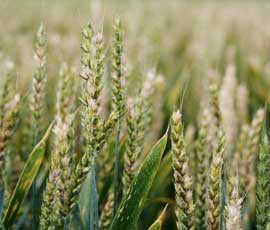Fusarium causes yield and quality concerns

Across the UK growers and agronomists have reported an exceptionally high prevalence of fusarium throughout the growing season.
While that will have an effect on yields, it won’t necessarily translate into problematic levels of mycotoxins, according to Agrii technical manager Chris Bean.
“This year I’ve seen more fusarium on the leaf than I’ve ever seen before and there’s definitely plenty in the ear right now.
“But it’s only certain strains of the disease that produce mycotoxins. Until we get results back for samples we’ve sent off for testing, we won’t know if it is those strains which we’re seeing so much of.”
Velcourt technical director Keith Norman has noted some interesting patterns. “We’ve been battling the worst ear disease I’ve seen in 30 years, but there has been some surprising trends. Where foliar disease control hasn’t been so good we’ve seen a lower incidence of issues in the ear.
“The only explanation for this can be that the healthier canopy has provided a green bridge for disease carry-over into the ear.”
In trials using different fungicide technologies (SDHIs and triazoles) no one type of product has stood out in what has been a very challenging season, says Mr Norman.
“The root of the problem is that while flowering should only last four to five days, this year it went on for more like two weeks. That gave disease the chance to get into grain sites and hence we’re seeing plenty of blinds.
“But we’re seeing a great disparity between varieties – while Claire is virtually unscathed, Oakleigh is absolutely smothered. It’s no coincidence breeders in the USA are looking to GM to work disease tolerance into new varieties.”
That’s a view echoed by NFU crops board chairman Andrew Watts. “My cleanest wheat is Scout. Its yields might be lower, but it could potentially offer the best returns – it will almost certainly make milling quality.
“Maybe it’s time for a bit of a rethink on variety choice. Perhaps we should be making our decisions on disease profiles first and on yield as a second priority.”
Yield penalties
Aside from the quality issues, fusarium’s more obvious effects of blind grain sites and partially empty ears are causing considerable yield concerns. In the worst-affected crops growers are bracing themselves for tonnages being knocked by up to 60%.
“The expectation is that high levels of fusarium in this year’s crops will have a negative effect on yield and quality,” explains Gleadall’s Jonathan Lane.
“But until we have grain coming in we just won’t know how big the problem is.”
Since March, milling premiums have risen from £10 to four times that today. That shows millers are anticipating that fewer crops will make the grade. But prices can’t keep rising.
“As premiums rise above the £40-£45-mark it starts to make importing grain from the continent a more economically viable proposition. That effectively puts a cap on the premium.”

